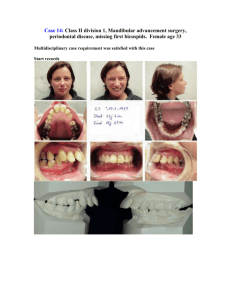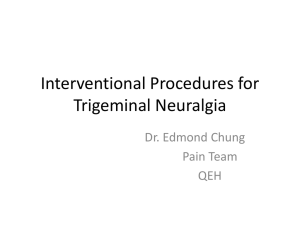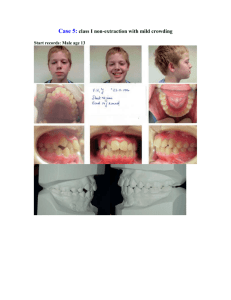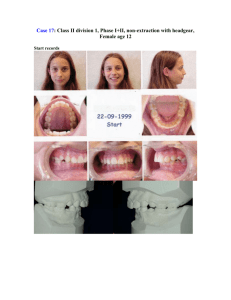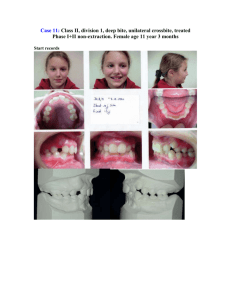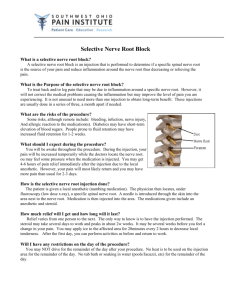Gow-Gates Mandibular Nerve Block
advertisement
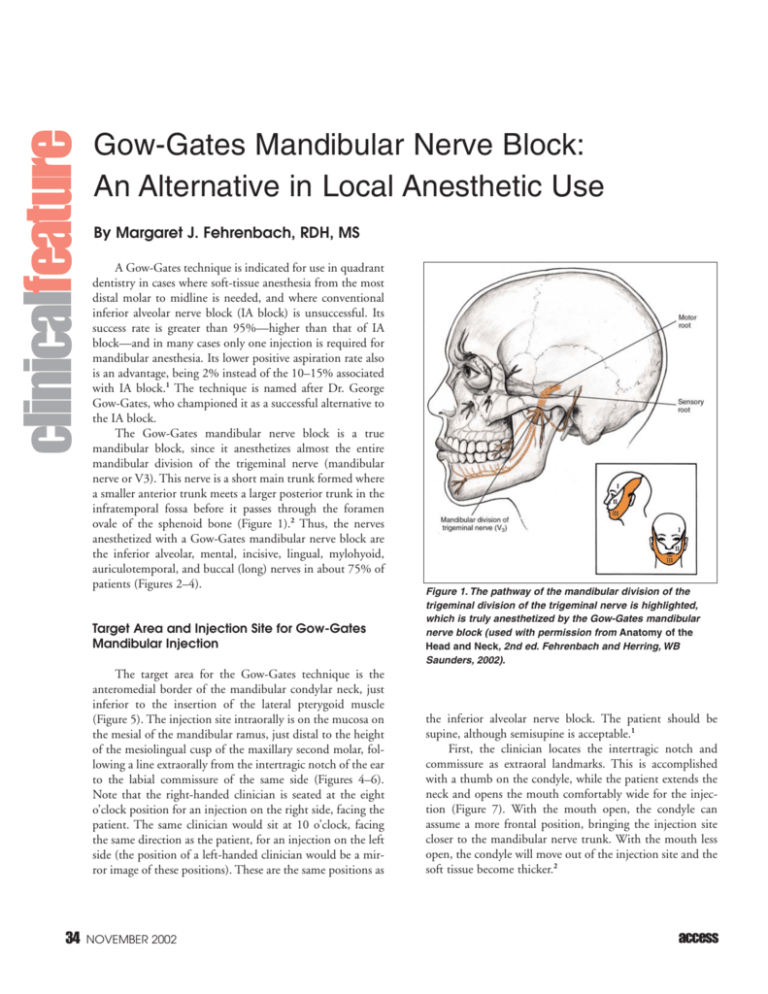
clinicalfeature Gow-Gates Mandibular Nerve Block: An Alternative in Local Anesthetic Use By Margaret J. Fehrenbach, RDH, MS A Gow-Gates technique is indicated for use in quadrant dentistry in cases where soft-tissue anesthesia from the most distal molar to midline is needed, and where conventional inferior alveolar nerve block (IA block) is unsuccessful. Its success rate is greater than 95%—higher than that of IA block—and in many cases only one injection is required for mandibular anesthesia. Its lower positive aspiration rate also is an advantage, being 2% instead of the 10–15% associated with IA block.1 The technique is named after Dr. George Gow-Gates, who championed it as a successful alternative to the IA block. The Gow-Gates mandibular nerve block is a true mandibular block, since it anesthetizes almost the entire mandibular division of the trigeminal nerve (mandibular nerve or V3). This nerve is a short main trunk formed where a smaller anterior trunk meets a larger posterior trunk in the infratemporal fossa before it passes through the foramen ovale of the sphenoid bone (Figure 1).2 Thus, the nerves anesthetized with a Gow-Gates mandibular nerve block are the inferior alveolar, mental, incisive, lingual, mylohyoid, auriculotemporal, and buccal (long) nerves in about 75% of patients (Figures 2–4). Target Area and Injection Site for Gow-Gates Mandibular Injection The target area for the Gow-Gates technique is the anteromedial border of the mandibular condylar neck, just inferior to the insertion of the lateral pterygoid muscle (Figure 5). The injection site intraorally is on the mucosa on the mesial of the mandibular ramus, just distal to the height of the mesiolingual cusp of the maxillary second molar, following a line extraorally from the intertragic notch of the ear to the labial commissure of the same side (Figures 4–6). Note that the right-handed clinician is seated at the eight o’clock position for an injection on the right side, facing the patient. The same clinician would sit at 10 o’clock, facing the same direction as the patient, for an injection on the left side (the position of a left-handed clinician would be a mirror image of these positions). These are the same positions as 34 NOVEMBER 2002 Figure 1. The pathway of the mandibular division of the trigeminal division of the trigeminal nerve is highlighted, which is truly anesthetized by the Gow-Gates mandibular nerve block (used with permission from Anatomy of the Head and Neck, 2nd ed. Fehrenbach and Herring, WB Saunders, 2002). the inferior alveolar nerve block. The patient should be supine, although semisupine is acceptable.1 First, the clinician locates the intertragic notch and commissure as extraoral landmarks. This is accomplished with a thumb on the condyle, while the patient extends the neck and opens the mouth comfortably wide for the injection (Figure 7). With the mouth open, the condyle can assume a more frontal position, bringing the injection site closer to the mandibular nerve trunk. With the mouth less open, the condyle will move out of the injection site and the soft tissue become thicker.2 access The use of a long 25gauge needle is recommended. Initially, the needle is placed just inferior to the mesiolingual cusp of the maxillary second molar to assess the approximate vertical coordinate for the injection site.1 The needle is then repositioned distal to the maxillary second molar maintaining the established height (Figure 8). The barrel of the needle is maintained over the contralateral-canineto-premolar region, so that the angulation of the syringe parallels a line connecting the commissure and the Figure 2. The pathway of the anterior trunk of the mandibular division of the trigeminal nerve is intertragic notch of the same highlighted, which includes the (long) buccal nerve that is anesthetized with the Gow-Gates side. The orientation of the mandibular nerve block (used with permission from Anatomy of the Head and Neck, 2nd ed. bevel of the needle tip is not Fehrenbach and Herring, WB Saunders, 2002). crucial for the block to be successful. The needle is inserted parallel to the determined line and slowly advanced until it makes bony contact with the neck of the condyle (Figure 9). The average depth of penetration is around 25 mm, similar to that of the IA block, although variation can be considerable. Depending on the patient's size, the height of insertion Figure 3. The pathway of the posterior trunk of the mandibular division of the trigeminal nerve is highlighted, which includes the auriculotemporal, lingual, inferior alveolar, mental, incisive, and mylohyoid nerves that are anesthetized by the Gow-Gates mandibular nerve block (used with permission from Anatomy of the Head and Neck, 2nd ed. Fehrenbach and Herring, WB Saunders, 2002). access Figure 4. Area anesthetized by a GowGates mandibular nerve block is highlighted and includes almost the entire mandibular nerve (used with permission from Anatomy of the Head and Neck, 2nd ed. Fehrenbach and Herring, WB Saunders, 2002). NOVEMBER 2002 35 should be withdrawn 1 mm, aspiration performed, and then the agent deposited. The volume of local anesthetic agent deposited is between 1.8 and 3.0 ml, since the nerve is thick and more than one cartridge may be needed. Most clinicians start with one cartridge and then add a portion of a second. Positive aspiration occurs less than 2% of the time. If bone is not contacted, the needle should be withdrawn slightly and redirected more anteriorly, so that the syringe is located more distally. If there is a positive aspiration and blood enters the cartridge, the needle is too far below the target area; the internal maxillary artery or its larger tributaries have been nicked. This injection is most often missed if attempted too low.2 After the injection, the patient should sit upright and keep the mouth open for two minutes to allow diffusion of the agent through the many anatomical structures. Some clinicians use a rubber bite block. Five to seven minutes should be allowed before proceeding with dental treatment, which is two to three minutes longer than for the IA block. Figure 5. Target area for the Gow-Gates mandibular nerve block is located at the anteromendial border of the mandibular condyle neck, just inferior to the insertion of the lateral pterygoid muscle (used with permission from Anatomy of the Head and Neck, 2nd ed. Fehrenbach and Herring, WB Saunders, 2002). Undesired Effects and Possible Complications of a Gow-Gates Mandibular Block The mandibular teeth to midline, the buccal mucoperiosteum and mucous membranes, and lingual soft tissues and periosteum will be anesthetized. Inadvertently, the anterior two-thirds of tongue, floor of mouth, body of mandible, and inferior ramus, as well as the skin over the zygoma and posterior cheek and temporal regions, are anesthetized.2 One disadvantage of the Gow-Gates technique is the anesthetization of the lower lip, as well as the temporal area. Another disadvantage is the amount of time before the anesthetic takes effect; a Gow-Gates injection takes longer to work because Figure 6. The extraoral line that is followed for the Gow-Gates mandibular nerve block. The line the nerve trunk being extends from the intertragic notch of the ear to the same side labial commissure (used with permisanesthetized is larger, and sion from Anatomy of the Head and Neck, 2nd ed. Fehrenbach and Herring, WB Saunders, 2002). farther from the site of deposition (5–10 mm).3 above the mandibular occlusal plane is 10–25 mm (greater The injection also lasts longer than the IA block because the than for IA block). The site of injection will be just distal to injection site is less vascular and a larger volume of anestheta third molar if one is present.1 ic may be needed. The injection is contraindicated in If there is no bony contact, the injection should not be patients with a limited ability to open the mouth; however, given. Once contact with bone has been made, the needle trismus is rarely involved. 36 NOVEMBER 2002 access Figure 7. The injection site for the Gow-Gates mandibular nerve block is probed at the soft tissues just distal to the height of the mesiolingual cusp of the second molar, following a line extraorally from the intertragic notch to the labial commissure of the same side (used with permission from Anatomy of the Head and Neck, 2nd ed. Fehrenbach and Herring, WB Saunders, 2002). Figure 8: Using the needle to assess the vertical location for the Gow-Gates mandibular nerve block by placing the needle just inferior to the mesiolingual cups of the maxillary second molar. Note that the barrel of the needle is over the contralateral canine-to-premolar region (used with permission from Anatomy of the Head and Neck, 2nd ed. Fehrenbach and Herring, WB Saunders, 2002). References 1. Malmed SF: Handbook of Local Anesthesia, 4th ed. Mosby, St. Louis, 1997. 2. Fehrenbach MJ, Herring SW: Illustrated Head and Neck Anatomy, 2nd ed. W.B. Saunders, Philadelphia, 2001. 3. Bath-Balogh M, Fehrenbach MJ: Illustrated Dental Embryology, Histology, and Anatomy, W.B. Saunders, Philadelphia, 1997. Margaret J. Fehrenbach, RDH, MS, is a private-practice dental hygienist who performs local anesthesia as an expanded function. She is also an adjunct faculty member at East Tennessee State University, Johnson City, Tennessee, and Marquette University, Milwaukee, Wisconsin. She also presents continuing education nationally and internationally. She may be reached by email at jonmarg@gte.net, or through her Web site at home1.gte.net/jonmarg. She would like to thank Doreen Naughton, RDH, BS, Dental Health Services, Seattle, Washington, for her help in obtaining the clinical photographs. Note: With additional education, examination, and licensure, dental hygienists in many states are allowed to administer local anesthetics. Since each state has its own specific regulations regarding the dental hygienist’s responsibilities, the author urges readers to contact their respective state licensing board for information and specific regulations concerning injections for local anesthesia. Careful research has been conducted to ensure that the information and recommendations contained herein are accurate and compatible with the standards of care generally accepted at the time of publication. The author disclaims any liability, loss, or damage incurred as a consequence, directly or indirectly, of the use and application of any of the contents of this article. access Figure 9. Needle penetration for the Gow-Gates mandibular nerve block is demonstrated at the soft tissues just distal to the maxillary second molar, maintaining the established height. The injection site is highlighted (used with permission from Anatomy of the Head and Neck, 2nd ed. Fehrenbach and Herring, WB Saunders, 2002). Online Sources of Additional Information American Academy of Orofacial Pain www.aaop.org/ American Dental Society of Anesthesiology www.adsahome.org/ American Society of Anesthesiologists www.asahq.org/ American Society for the Advancement of Anesthesia in Dentistry www.sedation4dentists.com/ American Society of Dentist Anesthesiologists www.asdahq.org/ Anesthesia Net anesthesia.net/ ◆a NOVEMBER 2002 37



